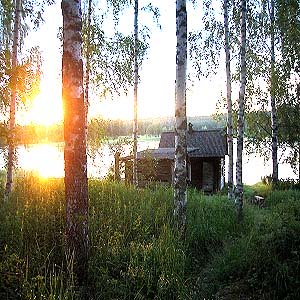|
Know your sauna history to understand the present
Early days of sauna history[Top] The earliest sauna was arguably the Yolngu sauna or bush sauna. 
This healing method comes from the Yolngu tribe of Australia, it was passed down over thousands of years by Yolngu tribes. Plants used to make the sauna include the gunga tree, laluk (pandanus nuts), gadayka, rakay, rangan and butjirinanging. MethodFirst the nuts are burnt with plenty of wood until they become ashes. Next the bark is taken off the gadayka tree, crushed and then soaked in water. When the bark is ready, it is spread over the ashes of the nuts. The raykay reeds are collected and put on top of the bark. The bark of the rangan tree is taken off in large sheets and put over the reeds, bark and ash. Next the person gets into the sauna and relaxes and meditates, while being massaged. Leaves from the butjirinanging tree are collected and boiled in big pot for two hours. The leaves distribute an oily substance which the sauna user is massaged and wash with. For more information about aboriginal healing methods see All herbal medicine knowledge of the Australian aborigines. The earliest known saunas in Europe were primarily pits. These were dug on elevated ground. They were used as a place of abode in the winter. The sauna comprised of a chimney. Then the stones were heated. Water was thrown on top of the heated stones to produce vapor. The temperature increased to such a level that that people could remove their clothing.
Where does the word sauna come from?[Top] Sauna is an ancient Finnish word. It refers to the Finnish traditional bath and to the bathhouse. Interestingly the word suovdnj in sami language means a pit which is dug out of the snow. Löyly[Top] When water splashes on hot rocks it creates steam vapour in Finland this is known as Loyly. It can also refer to the following.
Saunas like sweat lodges, have a strong connection with spirituality. The dead were washed there as well as worshipped. The finnish church in Rotherhithe, London, has a sauna.
The practice of Vihta[Top] The Finns also had the practice of vihta or the vasta. A bunch of birch twigs that have fresh leaves is gathered. Then this is slapped on the skin gently to create more stimulation of the cells and pores. Giving birth in a smoke sauna[Top] While much of Europe seldom bathed or never bathed, the Finns cleaned themselves in saunas once a week at the very least. The first thing people did when they moved was build a sauna.
How is this possible? This was possible because the smoke contained tannic acid, an anti-bacterial polymer. For many centuries the sauna was built separately to one's home, largely because of the risk of fire. The sauna is and was a big part of everyday life. The families bathed all together in the sauna at the house. The sauna was in the beginning supposed to be a mystical place of nature where differences sexes did not exist.
Sauna Evolution[Top] The sauna culture today is related to the Finnish culture. The development of the sauna occurred about the same time in Finland as well as the Baltic countries. They shared the same philosophies about the importance of the sauna in their daily life. They still share the same sauna customs to the present day. The Finnish immigrated to other places taking their traditions as well their sauna designs with them. As other cultures sat up and took notice the sauna evolved. When the Industrial revolution came, the sauna used a metal wood stove with a chimney. Temperatures in the air averaged around 80-70 degrees Celsius. The evolution included the electric furnace of the sauna, which appeared in the Fifties along with infrared saunas. Return from sauna history to hydrotherapy Return to natural healing home page
|
Loading


